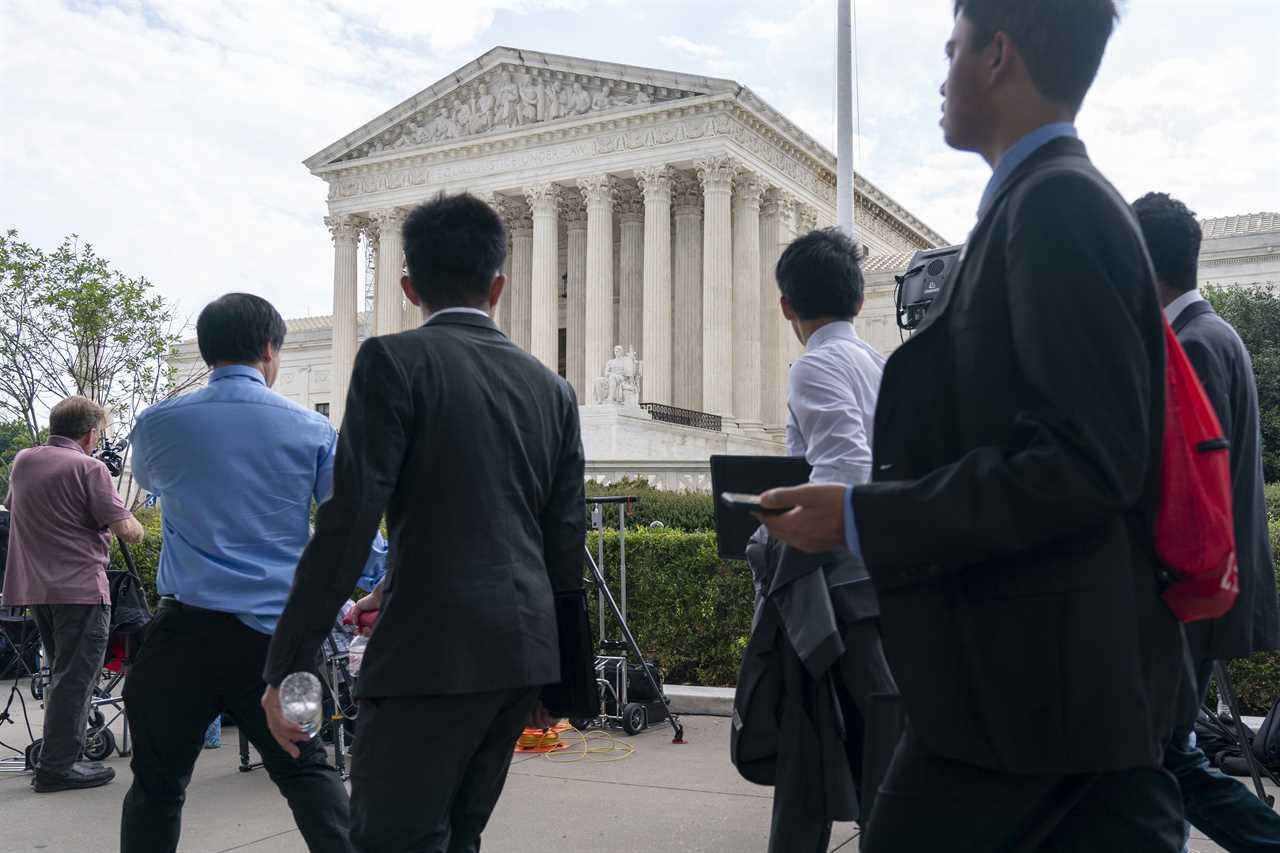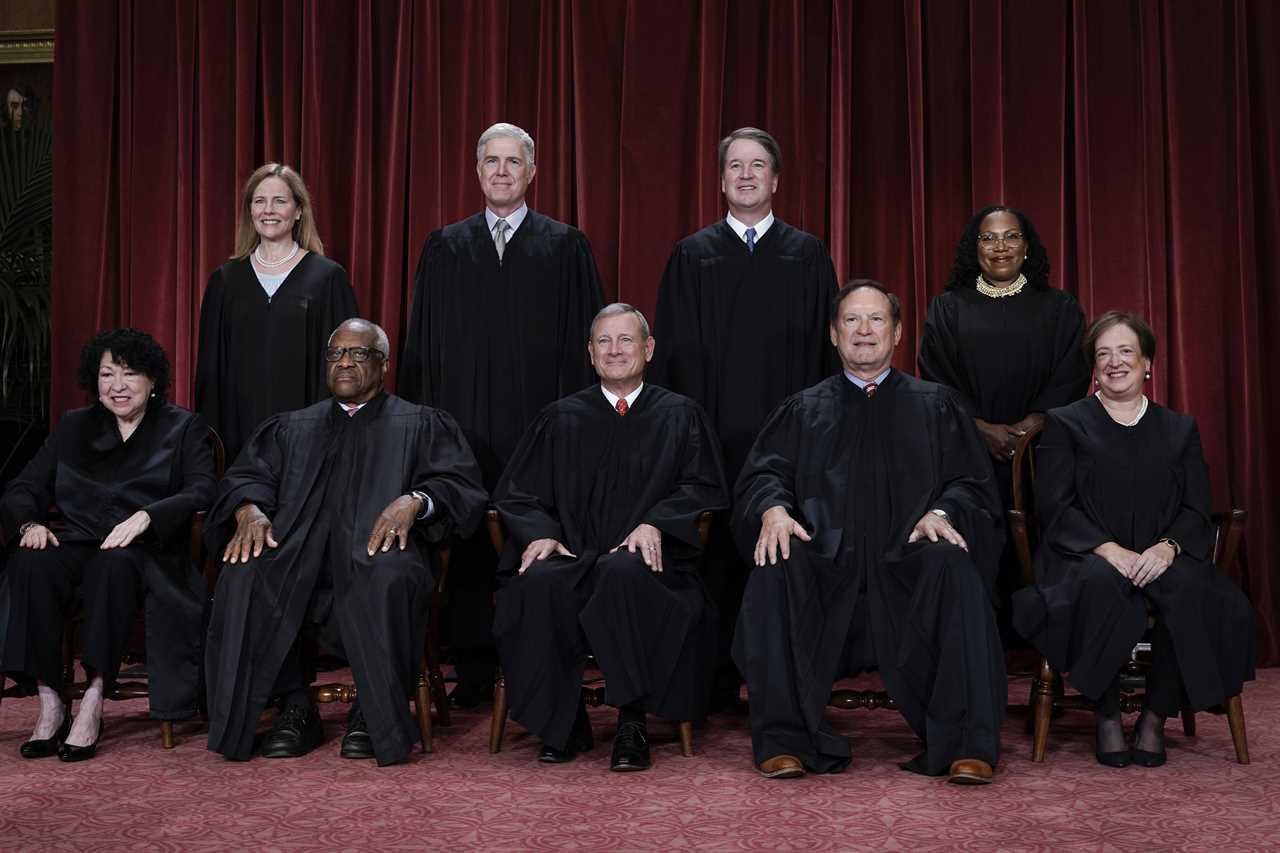
All it has taken to bring the Supreme Court to the brink of destruction, we’re supposed to believe, is a critical mass of justices who try to hew to the U.S. Constitution.
The institution survived Dred Scott and Plessy v. Ferguson, but is now hanging by a thread thanks to the ravages of Justices Clarence Thomas and Amy Coney Barrett.
It is fashionable to say that the Supreme Court has “a crisis of legitimacy.” In this telling, the court has been buffeted by undisclosed luxury vacations paid for by wealthy associates of conservative justices and undermined by “stolen” seats. The court’s polling is terrible and it is now, as Democratic Senate hopeful Adam Schiff put it at a pro-court-packing news conference recently, “a political and partisan court with a reactionary social agenda.”
Of course, many of the people on the left who are lamenting a crisis of legitimacy of the court are hoping to create just such a crisis. It is understandable that they don’t like the composition or drift of the current court after largely having it on their side for decades, but their attacks are meritless.
No one “stole” any Supreme Court seats. The Senate decides whether and when to confirm a president’s nominee. The Senate majority under Minority Leader Mitch McConnell decided to keep the seat that came open after the death of Antonin Scalia vacant pending the 2016 election. If Hillary Clinton had won that election, the way most people expected, there would have been no “stolen” seat. The same applies if Democrats had won the Senate in 2018 — they would have been able to block former President Donald Trump’s appointment of Barrett after Ruth Bader Ginsburg died.

There’s a difference between losing and being done dirty. The fact is that there was precedent both for a Senate majority blocking the nominee of a president of the opposite party in an election year and for a Senate majority rapidly confirming the nominee of a president of the same party in an election year; Senate control matters.
As for ethics, even if you think that Thomas and Justice Samuel Alito were imprudent in accepting free flights and nice trips, even if you think they should have disclosed these trips (they didn’t have to under the rules), it’s preposterous to believe that a lifetime of thought and jurisprudence that has been rigorously consistent for decades has been changed or influenced by a couple of vacations.
What’s the evidence for it? A common critique of Alito and Thomas is that they are too rigid.
Indeed, Thomas is the most fiercely independent mind and vote on the court. As for Alito, the smoking gun from ProPublica is supposed to be a case","link":{"target":"NEW","attributes":[],"url":"https://www.propublica.org/article/samuel-alito-luxury-fishing-trip-paul-singer-scotus-supreme-court","_id":"00000189-0690-d957-abed-aed838fe0004","_type":"33ac701a-72c1-316a-a3a5-13918cf384df"},"_id":"00000189-0690-d957-abed-aed838fe0005","_type":"02ec1f82-5e56-3b8c-af6e-6fc7c8772266"}">ProPublica is supposed to be a case that came before the court involving a dispute over bonds between the government of Argentina and a hedge fund owned by Paul Singer, who six years earlier gave him a lift on his private jet to a fishing trip they both attended.
Alito was not a lone vote, sticking out from everyone else with an unconvincing defense of Singer’s hedge fund. Rather, he was part of a 7-vote majority finding for the hedge fund (the Singer connection didn’t have to be, and wasn’t, disclosed in the parties’ briefs).
It’s not unusual, by the way, for Supreme Court justices to take trips funded by others. In 2018 alone, Ginsburg took 14 and Justice Stephen Breyer took a dozen.
More fundamentally, the court’s jurisprudence isn’t political. This doesn’t mean that the court always gets it right, or the conservative justices don’t ever let their personal predilections and attitudes affect their jurisprudence — everyone is human.
But the conservative justices are trying to abide by a standard of the original meaning of the Constitution.
Originalism, too, isn’t flawless. There are different versions of it, and it’s a function of the difficulty of some of the questions that reach the court that originalists can come down in different places. But originalism is an internally consistent, intuitively appealing theory of how the court should work that hasn’t been matched by any alternate theory of interpretation by the other side, which is why even the progressive justices will sound, at times, like originalists.
Is originalism just a smoke screen for a political agenda? No.
For instance, originalist justices have tended to vindicate what used to be core liberal priorities, from trial by jury to free speech.
The example of the late Antonin Scalia, originalism’s most influential apostle, is instructive. Scalia wasn’t always happy with where his jurisprudence took him. He hated flag burning, yet found, along with the liberal William Brennan, that it was protected speech. He was a law-and-order conservative, yet often ruled in favor of the rights of defendants. If it had been his druthers as a policy matter, he might have been happy to search homes for signs of marijuana cultivation with heat detectors, but he ruled against it. It was with an eye to these matters that David M. Dorsen wrote his book, “The Unexpected Scalia: A Conservative Justice’s Liberal Opinions.”
Consider other politically sensitive cases. In the 2021 case California v. Texas, the court found that Texas and other red state plaintiffs lacked the standing to challenge Obamacare. The court voted 7-2, with Barrett joining liberal Justices Sonia Sotomayor, Elena Kagan and Breyer, among others, in the majority.
This despite Senate Majority Leader Chuck Schumer asserting during her confirmation fight that “[a] vote by any senator for Judge Amy Coney Barrett is a vote to strike down the Affordable Care Act and eliminate protections for millions of Americans with preexisting conditions,” and President Joe Biden, then running for president, warning that “her confirmation could have a lasting impact on the more than 2 million Americans who had tested positive for the coronavirus.”
Of course, no one ever goes back and says “sorry,” or that they got her all wrong.
The same scenario played out in Tuesday’s decision in Moore v. Harper. In a 6-3 ruling, three conservatives and three liberals together rejected the contention of North Carolina Republicans that under the U.S. Constitution, state legislatures have almost unchecked power to fashion the rules for federal elections.
The worry when the Supreme Court took up the case was that the same “independent state legislature” theory could be used by Trump to try to overturn the 2024 election, should be the nominee and lose the general election. Washington Post editorial board opined that Roberts and his conservative colleagues","link":{"target":"NEW","attributes":[],"url":"https://www.washingtonpost.com/opinions/2022/07/05/supreme-court-independent-state-legislature-theory/","_id":"00000189-0690-d957-abed-aed838fe0010","_type":"33ac701a-72c1-316a-a3a5-13918cf384df"},"_id":"00000189-0690-d957-abed-aed838fe0011","_type":"02ec1f82-5e56-3b8c-af6e-6fc7c8772266"}">The Washington Post editorial board opined that Roberts and his conservative colleagues, in service of their MAGA masters, were “poised” to accept the theory, “not because the Constitution demands it, but because they can.”
Speaking of elections, the Supreme Court rejected all of Trump’s challenges to the 2020 election. In the most important case, again brought by Texas, the court issued an unsigned opinion saying the state “has not demonstrated a judicially cognizable interest in the manner in which another state conducts its elections.” Thomas and Alito thought, as a technical matter, the court can’t simply turn away cases where one state files to sue another, but gave no indication of buying any of Texas’ claims. Trump was not amused. “The Supreme Court really let us down,” he tweeted at the time.
Then, of course, there’s Dobbs. It shouldn’t have been a surprise that the court overturned Roe v. Wade. Legal conservatives had made a vigorous, intellectually serious argument against the decision for 50 years.
As it turns out, the justices didn’t do Republicans, or themselves, any political favors. If they had wanted to protect the GOP from a political backlash, they could have taken the off-ramp suggested by (the habitually cautious) Roberts of only going so far as to approve a 15-week abortion ban. And the court’s drop in polling is pretty much a direct result of the ruling in Dobbs, which should have been foreseeable and would have been avoided by a court of political operators.
Finally, that the conservatives justices don’t necessarily vote in lockstep is a sign that they are legitimately thinking through cases and aren’t toeing a preconceived political line.
While we still await big decisions on affirmative action and Biden’s student debt relief program, a POLITICO analysis last week found notable conservative divisions this term. “In the 39 decisions in argued cases that the court has handed down to date,” according to the story, “the three justices most often dissatisfied with the results have been the three most conservative justices. Justice Samuel Alito has dissented in 10 cases this term, Clarence Thomas has dissented in nine and Neil Gorsuch has dissented in seven.”
Of course, the court is coming down differently on a range of issues than it did in past decades. If faithfulness to the original meaning of the Constitution and statue is your lodestar, that’s not a bug — or a crisis — but a feature.
----------------------------------------
By: Rich Lowry
Title: Opinion | The Fake Crisis at the Supreme Court
Sourced From: www.politico.com/news/magazine/2023/06/29/fake-crisis-supreme-court-00104106
Published Date: Thu, 29 Jun 2023 03:30:00 EST






